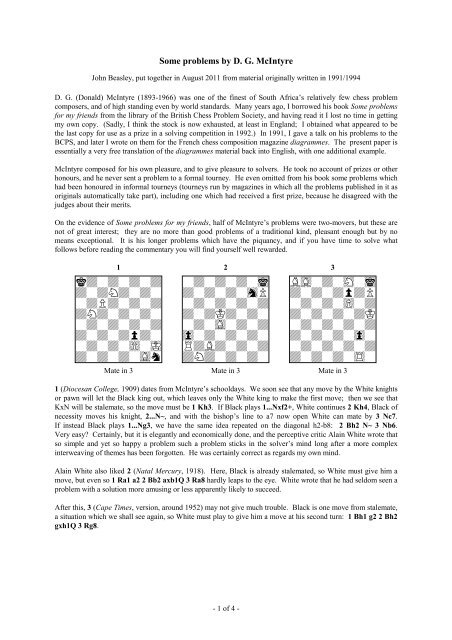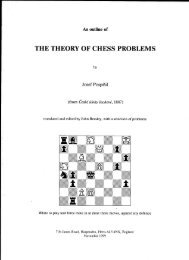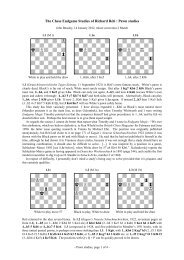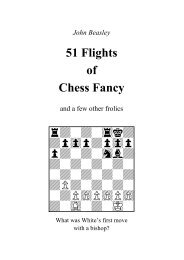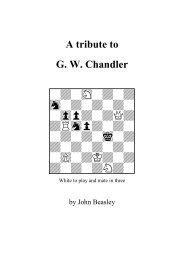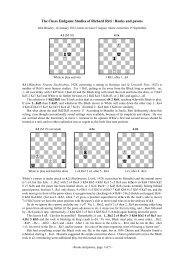Some problems by D. G. McIntyre - John and Sue Beasley
Some problems by D. G. McIntyre - John and Sue Beasley
Some problems by D. G. McIntyre - John and Sue Beasley
Create successful ePaper yourself
Turn your PDF publications into a flip-book with our unique Google optimized e-Paper software.
<strong>Some</strong> <strong>problems</strong> <strong>by</strong> D. G. <strong>McIntyre</strong><br />
<strong>John</strong> <strong>Beasley</strong>, put together in August 2011 from material originally written in 1991/1994<br />
D. G. (Donald) <strong>McIntyre</strong> (1893-1966) was one of the finest of South Africa’s relatively few chess problem<br />
composers, <strong>and</strong> of high st<strong>and</strong>ing even <strong>by</strong> world st<strong>and</strong>ards. Many years ago, I borrowed his book <strong>Some</strong> <strong>problems</strong><br />
for my friends from the library of the British Chess Problem Society, <strong>and</strong> having read it I lost no time in getting<br />
my own copy. (Sadly, I think the stock is now exhausted, at least in Engl<strong>and</strong>; I obtained what appeared to be<br />
the last copy for use as a prize in a solving competition in 1992.) In 1991, I gave a talk on his <strong>problems</strong> to the<br />
BCPS, <strong>and</strong> later I wrote on them for the French chess composition magazine diagrammes. The present paper is<br />
essentially a very free translation of the diagrammes material back into English, with one additional example.<br />
<strong>McIntyre</strong> composed for his own pleasure, <strong>and</strong> to give pleasure to solvers. He took no account of prizes or other<br />
honours, <strong>and</strong> he never sent a problem to a formal tourney. He even omitted from his book some <strong>problems</strong> which<br />
had been honoured in informal tourneys (tourneys run <strong>by</strong> magazines in which all the <strong>problems</strong> published in it as<br />
originals automatically take part), including one which had received a first prize, because he disagreed with the<br />
judges about their merits.<br />
On the evidence of <strong>Some</strong> <strong>problems</strong> for my friends, half of <strong>McIntyre</strong>’s <strong>problems</strong> were two-movers, but these are<br />
not of great interest; they are no more than good <strong>problems</strong> of a traditional kind, pleasant enough but <strong>by</strong> no<br />
means exceptional. It is his longer <strong>problems</strong> which have the piquancy, <strong>and</strong> if you have time to solve what<br />
follows before reading the commentary you will find yourself well rewarded.<br />
1 2 3<br />
kdwdwdwd wdwdwdwi BGwdwHwi<br />
dwdNdwdw dwdwdwhP dwdwdpdP<br />
wdPdwdwd wdwdwdwd wdwdw)wd<br />
dNdwdwdw dwdKdwdw dwdwdwdK<br />
wdwdwdwd wdwGwdwd wdwdwdwd<br />
dwdwdpdw 0wdwdwdw dwdwdw0w<br />
wdwdw)wI RdBdwdwd wdwdwdwd<br />
dwdwdwGn dNdwdwdw dwdwdw$w<br />
Mate in 3 Mate in 3 Mate in 3<br />
1 (Diocesan College, 1909) dates from <strong>McIntyre</strong>’s schooldays. We soon see that any move <strong>by</strong> the White knights<br />
or pawn will let the Black king out, which leaves only the White king to make the first move; then we see that<br />
KxN will be stalemate, so the move must be 1 Kh3. If Black plays 1...Nxf2+, White continues 2 Kh4, Black of<br />
necessity moves his knight, 2...N~, <strong>and</strong> with the bishop’s line to a7 now open White can mate <strong>by</strong> 3 Nc7.<br />
If instead Black plays 1...Ng3, we have the same idea repeated on the diagonal h2-b8: 2 Bh2 N~ 3 Nb6.<br />
Very easy? Certainly, but it is elegantly <strong>and</strong> economically done, <strong>and</strong> the perceptive critic Alain White wrote that<br />
so simple <strong>and</strong> yet so happy a problem such a problem sticks in the solver’s mind long after a more complex<br />
interweaving of themes has been forgotten. He was certainly correct as regards my own mind.<br />
Alain White also liked 2 (Natal Mercury, 1918). Here, Black is already stalemated, so White must give him a<br />
move, but even so 1 Ra1 a2 2 Bb2 axb1Q 3 Ra8 hardly leaps to the eye. White wrote that he had seldom seen a<br />
problem with a solution more amusing or less apparently likely to succeed.<br />
After this, 3 (Cape Times, version, around 1952) may not give much trouble. Black is one move from stalemate,<br />
a situation which we shall see again, so White must play to give him a move at his second turn: 1 Bh1 g2 2 Bh2<br />
gxh1Q 3 Rg8.<br />
- 1 of 4 -
4 5a 5b<br />
kdNHwdw$ wdwdwdwd wdwdwdwd<br />
)wdwdKdw Iw0pdwdw dwIw0pdw<br />
wdwdwdwd wdPdwdwd wdwdPdwd<br />
dwdwdwdw dwGw0wdw dwdwGw0w<br />
wdwdwdwd w)wdkdwd wdw)wdkd<br />
dpdwdwdw dwdwdwdw dwdwdwdw<br />
pdwdwdwd BdwdPdwd wdBdwdPd<br />
$wdwdwdw dwdwdRdw dwdwdwdR<br />
Mate in 3 Mate in 3 Mate in 3<br />
4 (Natal Mercury, 1942) is one of my favourites. The apparent attack along the top rank is a snare <strong>and</strong> a<br />
delusion, <strong>and</strong> the rook on h8 must bury itself on a new line: 1 Rh1 b2 2 Rhb1! There follows 2...axb1Q 3 Nb6<br />
<strong>and</strong> 2...bxa1Q 3 Rb8, the capture of either rook allowing the other to come into effect. The South African chess<br />
enthusiast A. J. A. Cameron, having solved it, said that <strong>problems</strong> like this shouldn’t be allowed.<br />
5 (Natal Mercury, 1917) is a twin composition, the position of 5a being shifted two files to the right to give 5b.<br />
In each case, Black will be stalemated after ...PxP, so White must prepare a remedy. In 5a, it is 1 Bg8 dxc6<br />
2 Rf7, releasing the stalemate for 2...Kd5 3 Rf4. If instead 1...d6 then 2 Bg1 (on f2, the bishop would obstruct<br />
the rook), with 2...d5 3 Bh7; if 1...d5 then 2 Bh7 gives mate at once. The loss of the g <strong>and</strong> h files prevents<br />
White from doing the same in 5b, but he can turn the proximity of the edge to his own advantage <strong>by</strong> playing<br />
1 Rh8 for 1...fxe6 2 Bh7 Kh~ 3 Bf5. Now, if Black tries 1...f6 White can play 2 Bh2 (the rook having played to<br />
h8, this move no longer obstructs it) for 2...f5 3 Bd1; again if 1...f5 then 2 Bd1 gives mate at once. The bishop<br />
moves to allow the rook to obstruct it <strong>and</strong> relieve stalemate in 5a, the rook returns the compliment in 5b.<br />
6 7 8<br />
wdwdwdwd wdwdwdwd wdwdwdwd<br />
dwdwdwdp dwdwdwdp dwdwdwdw<br />
wdw0wdw) wdw0wdwI wdwdwdpd<br />
dwdPdwdw dwdPdwdw dwdwdwdw<br />
wdpdwdwd wdwdwdR) wdwdwdwd<br />
dwdw0wGR 0wGwdB)w dw0wHwdw<br />
wdPdP0w) phwdwdwd wdPdPdw0<br />
dwdwdKdk ib$wdwdw dw$K$wgk<br />
Mate in 3, (b) after the key of (a) Mate in 4 Mate in 6<br />
6 (1926, source not given) is another twin problem, 6a being the diagram position <strong>and</strong> 6b the position after the<br />
first move of the solution has been played. Again Black is about to stalemate himself, <strong>and</strong> in 6a the solution is<br />
1 Rh5 c3 2 Bh4 Kxh2 3 Bf2; the rook retreats so that the bishop can interpose <strong>and</strong> relieve the stalemate, <strong>and</strong><br />
the bishop then discovers mate. In 6b, with the rook already on h5, this cannot be made to work, but White can<br />
play 1 Bxd6 c3 2 Re5 Kxh2 3 Rh5, the roles of the rook <strong>and</strong> bishop again being reversed.<br />
In 7 (Queenstown Daily Representative, 1940), two separate stalemate-release lines are presented as variations.<br />
Play starts with 1 Kg7 releasing the initial stalemate, <strong>and</strong> does Black advance his pawn one square or two? If he<br />
advances it one square only, 1...h6, White must get his rook off g4 so that Black cannot capture it at move 3, <strong>and</strong><br />
the play is 2 Bf6 h5 3 Rd4 N~ 4 RxN. If Black advances the pawn two squares, 1...h5, it is the bishop on f3 that<br />
White must get out of its reach, <strong>and</strong> the play is 2 Re1 hxg4 3 Bd1 B~ 4 B(x)c2.<br />
8 (Natal Mercury, 1922) is another problem where White will have to unpin Black on the penultimate move.<br />
This time he has four moves to get everything into position: 1 Ra1 g5 2 Kc1 g4 3 Kb1 g3 4 Rc1 g2 5 Nd1 B~<br />
6 N(x)f2.<br />
- 2 of 4 -
9 10 (with C. A. L. Bull)<br />
NHwdwdwd<br />
0w$wdwdw<br />
wdw)w)wd<br />
dPdw!Pdw<br />
kdK$wdwd<br />
4ndp0pdw<br />
bdBdwdwd<br />
dwdwGwdw<br />
NdwHwdwd<br />
dwdwdwdw<br />
bdPdwdw)<br />
4rindw!K<br />
w0wdwdp)<br />
0w0w$wdw<br />
q0w)wdwG<br />
dwdwdBdw<br />
Selfmate in 3 Selfmate in 3<br />
The <strong>problems</strong> so far have come into the category of “piquant lightweights”. 9 <strong>and</strong> 10 are not lightweight at all;<br />
quite the reverse. Play in 9 (Alain White Album, 1920) starts 1 Re7, blocking e7 so that 2 Kd5+ Kxb5 3 Ke6+<br />
Nc5 becomes a threat, <strong>and</strong> Black has three defences. He can play 1...Bb1 to take the bishop off the threatened<br />
mating line, but now it bears on d3 instead <strong>and</strong> White can reply 2 Kc3+ Ka5 3 Kxd3+ forcing 3...Nd2; on b1,<br />
the bishop pins the White bishop, so this is now mate. Black can play 1...d2 releasing a5 for his king, but it<br />
doesn’t help: 2 Kd3+ Ka5 3 b6+ forces 3...Nc5, which is again mate even though the White king is on a very<br />
different square. Finally, he can play 1...dxc2, unpinning his knight so that it can get into play earlier; no,<br />
2 Nb6+ axb6 (this pawn now guards c5) 3 Ra7+ Na5 <strong>and</strong> again the knight has been forced to give mate. I noted<br />
in diagrammes that I had once set this in a solving competition, <strong>and</strong> although I don’t have a record of how many<br />
solvers it defeated, I commented in diagrammes, “ah, les malheureux!”<br />
(In a solving contest, a problem which nobody can do is worse than useless, but to spread out the marks at the<br />
top end there should be some on which about half the leading solvers are expected to fail. With solvers of<br />
international class in the field, <strong>and</strong> two hours for a dozen <strong>problems</strong> some of which were relatively easy, this<br />
probably did the job pretty well.)<br />
In 10 (with C. A. L. Bull, Natal Mercury, 1918, version), 1 Re8 clears the diagonal so that 2 Bg1+ Kd6 3 Qg6+<br />
Nf6 becomes a threat. Black has various defences: 1...Kd4 2 Ne6+ Ke4 3 Qxg4+ Nf4, 1...Qc4 2 Bd6+ with<br />
2...Kxd6 3 Qe7+ Nxe7 <strong>and</strong> 2...Kd4 3 Qxg4+ Nf4, 1...Bc8 2 Bg1+ Kd6 3 Qf4+ Nxf4, 1...Qb1/b1Q 2 Bg1+<br />
Kd6 3 Qf6+ Nxf6, <strong>and</strong> 1...b3 2 Bg1+ Kb4 (2...Kd6 3 Qg6+ as before) 3 Qxg4+ Nf4. The White queen gives<br />
her decisive check from five different squares, <strong>and</strong> the differentiations between Qg6+/Qg4+ (needed to block g6<br />
or g4 in various lines) <strong>and</strong> Qf6+/Qf4+ (playable when Black has guarded g6 or g4) will be noted.<br />
These are true masterpieces, with full-length play in all lines <strong>and</strong> no dual at any point, <strong>and</strong> they were created long<br />
before computers simplified the composer’s task <strong>by</strong> doing the testing for him. In the days when I used to solve<br />
more seriously than I do now, I found that nothing gave more satisfaction than a really good three-move<br />
selfmate; the two-edged nature of Black’s moves gave it a flavour quite unlike that of any other chess problem.<br />
11a<br />
wdwdwdwd<br />
dwdwdwdw<br />
wdQdwdwd<br />
dpdrdwdw<br />
wdwdwHwd<br />
dwdwdwdN<br />
w)wdwdw0<br />
Iwdwdwdk<br />
11b<br />
wdwdwdwd<br />
dwdwdwdw<br />
pdQdwdwd<br />
dwdrdwdw<br />
wdwdwHwd<br />
0wdwdwdN<br />
Pdwdwdw0<br />
Iwdwdwdk<br />
Selfmate in 7 Selfmate in 7<br />
11 (Natal Mercury, 1920) brings us back to the world of the lightweights. This is not a twin in the sense of<br />
5a/5b or 6a/6b, but rather two different settings of the same idea. In 11a, 1 Ka2 (we shall need to lose a move)<br />
b4 2 Kb1 b3 3 Qc1+ Rd1 4 Ka1 <strong>and</strong> we have the “little <strong>by</strong> little” theme: 4...Re1 5 Qd1 Rf1 6 Qe1 Rg1 7 Qf1<br />
Rxf1. In 11b, it is the queen that must lose the move: 1 Qa8 a5 2 Qb7 a4 3 Qb1+ Rd1 4 Qc1 <strong>and</strong> the same.<br />
- 3 of 4 -
12 13<br />
wdRGwdwwwwwwwwwww<br />
wwdKdwwwwwwwwwwwd<br />
wdwdwdwwwwwwwwwdw<br />
wwwwwwwwdwwdwdwwd<br />
wwwwwwwwwwwwdwwww<br />
0wdwdwdwdwwdBdww0<br />
wwwwwwwwwwww0wwwP<br />
)wdwdwdwdwwdkdwwd<br />
Reconstruct the diagram (three possibilities), then mate in three<br />
wdwdwdwd<br />
dwdwdwdw<br />
wdwdwdwd<br />
dwdwdwdw<br />
wdwdwdw0<br />
dwdwdwdw<br />
Rdwdwdwd<br />
dwIRdwgk<br />
What is the position?<br />
12 shows an eight-piece jigsaw which came into the BCPS Library some years ago, possibly in a large batch of<br />
material h<strong>and</strong>ed on <strong>by</strong> the heirs of the heirs of C. S. Kipping. The task is to reassemble the pieces as a chess<br />
diagram (the solver receives them loose in an envelope, so the pieces without men may be placed in any<br />
orientation), <strong>and</strong> then to solve the resulting three-mover. There are in fact three ways of reassembling the pieces,<br />
giving three distinct <strong>problems</strong>. And 13 appears on the jacket of <strong>Some</strong> <strong>problems</strong> for my friends in a design <strong>by</strong><br />
B. W. Dumbleton depicting pieces from an old French set, with the question: what is the position?<br />
12a 12b 12c<br />
wdwdwdwd wdwdwdwd wdwdwdwd<br />
dw0wdwdw dwdwdw0w dwdwdwdw<br />
wdwdBdwd wdwdBdwd wdwdBdwd<br />
dw)w0wdw dwdw0w)w dwdw0wdw<br />
w0wdkdwd w0wdkdwd w0wdkdw0<br />
dPdRGwdw dPdRGwdw dPdRGwdw<br />
wdwdKdwd wdwdKdwd wdwdKdw)<br />
dwdwdwdw dwdwdwdw dwdwdwdw<br />
Mate in 3 Mate in 3 Mate in 3<br />
12 is not in fact difficult. It is soon seen that the 3x7 piece containing the White king must go at the bottom, else<br />
there will be nowhere for the 7x2 piece to go, <strong>and</strong> that the 5x5 piece containing the Black king must go above it.<br />
The 7x2 piece can now go on the a <strong>and</strong> b files, neatly nestling on the b1 toe of the 3x7 piece, <strong>and</strong> the 5x1 piece<br />
can occupy the rest of the a-file. This leaves only c5-c8, g5-g8, <strong>and</strong> h2-h8 to be filled, <strong>and</strong> if we are to preserve<br />
the normal chequering the 4x1 piece containing the pawns must go on c5-c8, g5-g8, or h2-h5. This gives us our<br />
three <strong>problems</strong>. Each of them shows <strong>McIntyre</strong>’s favourite “stalemate release” theme. In 12a, the rook moves<br />
across d7 to let itself be obstructed <strong>by</strong> the bishop, 1 Rd8 b6 2 Bd7 Kd5 3 Bf5; in 12b, the bishop returns the<br />
compliment, 1 Bc8 g6 2 Rd7 Kf5 3 Rd4; <strong>and</strong> in 12c, it is the other bishop which retreats, 1 Bc1 h3 2 Rd2 Kf4<br />
3 Rd4.<br />
There is no solution to 13 in <strong>Some</strong> <strong>problems</strong> for my friends, <strong>and</strong> in 1991 I could see nothing beyond the fact that<br />
it seemed to give a mate in four <strong>by</strong> 1 Rf2 h3 2 Kd2 etc. Eventually a penny dropped. Suppose we uncastle the<br />
White king <strong>and</strong> rook, <strong>and</strong> move the Black bishop back to d4; we now have an amusing switchback mate in five<br />
<strong>by</strong> 1 0-0-0+ Bg1 2 Rf2 h3 3 Kd2 h2 4 Ke1 Bxf2 5 Kxf2. I have no idea whether this is correct, let alone where<br />
the problem was originally published, but no better idea has come to mind. I did wonder whether we could<br />
avoid the checking start <strong>by</strong> leaving the bishop on g1 <strong>and</strong> moving the pawn back to h4 instead, but the computer<br />
told me that 1 Kf1 was a cook.<br />
David Friedgood, although long resident in Engl<strong>and</strong>, was brought up in South Africa <strong>and</strong> knew <strong>McIntyre</strong> well,<br />
<strong>and</strong> remembers him with considerable affection. He regards <strong>McIntyre</strong> as a very good composer rather than a<br />
great one, <strong>and</strong> certainly <strong>McIntyre</strong> was not as prolific as some have been; but very few composers have equalled<br />
the best of what appears here.<br />
- 4 of 4 -


